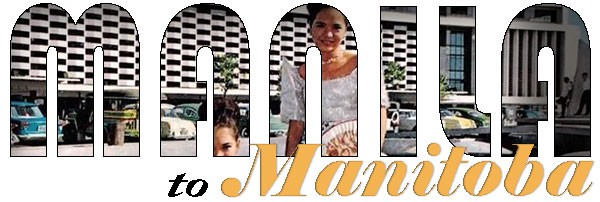of the Kapitana and Tinyente into its November town fiesta.
November 23 is a special day for the people of my parent’s hometown. It is the day the people of Angono, Rizal celebrate their patron saint, Saint Clement (San Clemente). After 9 days of prayer, the town comes together for a lively, colourful, and musical parade down its historic and narrow streets. Mothers, fathers, children, and grandparents come out to march in the procession or squeeze through crowds to find the best view. People throw water and the marching bands play music. There are cheers and drunken laughter (from those starting the celebration early). It is a lively time in Angono to watch the statue of Saint Clement make its way around the town.
In Winnipeg, this tradition carries on.
The Angono Rizal Association of Winnipeg (ARAW) has hosted the same prayer and celebration for as long as I can remember. Although the celebrations were smaller when I was a kid (think pinatas and potato sack races), it has since gained new energy in recent years. There are a great number of newcomers from Angono who now reside here. They may have come under the Manitoba Provincial Nominee Program to put their skills to work, but they have also brought a new sense of modernity to our regional celebration. Gone are the days when the elders only spoke Tagalog. Instead, it is a mix of young and old communicating in modes of Tag-lish (Tagalog and English). The divide is no longer as pronounced. During the weekend, we celebrated not only the tradition of our patron saint, but the idea of nostalgia, culture, imagination, and belonging.
The Philippine fiesta is a Catholic tradition brought from the Spaniards in the 1500s. It incorporates Catholic Saints and religious rites. However, one might notice that the celebration is also much more. The imagery of the higantes (paper mache giants) and the parehadoras (female devotees carrying small wooden oars) imply that there are also pre-Catholic traditions that remain. Here, we too celebrate the ocean and its offerings to the people whose livelihood depend on her. In much the way this evolution has taken place, I imagine the same thing is happening here in Winnipeg.
Instead of marching through the streets of Winnipeg (it is winter here by the way), we gather at the local parish hall. We delight in the endless amount of food everyone has contributed towards. We hold 50/50 raffles and silent auctions to finance this gathering. The marching band music is no longer live, but we dance nevertheless to the DJ who plays it. Our higantes resemble some of the members of our own community and our parehadoras are now elderly. We still throw water, but we also hear our mothers scold us in the background. We throw coins at our own Kapitana and Tinyente as they perform the traditional Easter dance (even if it’s not Easter yet). This is the Angono fiesta in Winnipeg.
I hope as I get older I will look back and smile at the ways the traditions have changed over the years. Maybe, I will smile the same way my parents do when they hear a familiar song from the Philippines. I’ll think back and overlook the fact that it wasn’t played in its purest traditional form, but in an adapted way to suit the needs we have – at home away from my imagined Filipino home.



